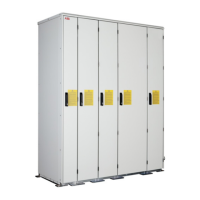Safety instructions 15
Safe start-up and operation
General safety
These warnings are intended for all who plan the operation of the converter or operate the
converter. Ignoring the instructions can cause physical injury or death or damage to the
equipment.
WARNING!
• Before adjusting the converter and putting it into service, make sure that the generator
and all driven equipment are suitable for operation throughout the speed range
provided by the converter.
• The doors of the converter must be kept locked when the converter is in operation.
• Before power switch-on, make sure that the liquid cooling circuit is filled up with
coolant. Running the pump dry will damage it and the converter will not cool down.
• Do not control the generator with the disconnecting device (means); instead, use the
commands via I/O board of the converter or via fieldbus.
Note:
• It is not allowed to start-up the converter more often than once in two minutes during
commissioning. In normal use it is not allowed to do repetitive start-ups more often
than once in 10 minutes. Avoid frequent start-ups.
• If an external source for start command is selected and it is ON, the converter will start
immediately after fault reset unless the converter is configured for a pulse start/stop by
a parameter.
WARNING! Do not work on the converter when the generator is rotating. Also,
when the input power is switched off and the converter is stopped, a rotating
generator may feed power to the intermediate circuit of the converter and the
power connections become live.
• Before installation and maintenance work on the converter:
• Stop the converter and the generator.
• Ensure that the generator cannot rotate during work. Lock the shaft mechanically
(eg, by using a brake). Make sure that wind or other systems, like hydraulic
crawling drives, are not able to rotate the generator directly or through any
mechanical connection like felt, nip, rope, etc.
Ensure that there is no voltage on the converter power terminals:
Alternative 1) Disconnect the generator from the converter with a safety switch or by other
means. Measure that there is no voltage present on the converter grid-side or rotor-side
terminals (L1, L2, L3, U2, V2, W2, UDC+, UDC-).
Alternative 2) Measure that there is no voltage present on the grid-side or rotor-side
terminals of the converter (L1, L2, L3, U2, V2, W2, UDC+, UDC-). Ground the converter
grid-side and rotor-side terminals temporarily by connecting them together as well as to
the PE.
Alternative 3) If possible, both of the above.

